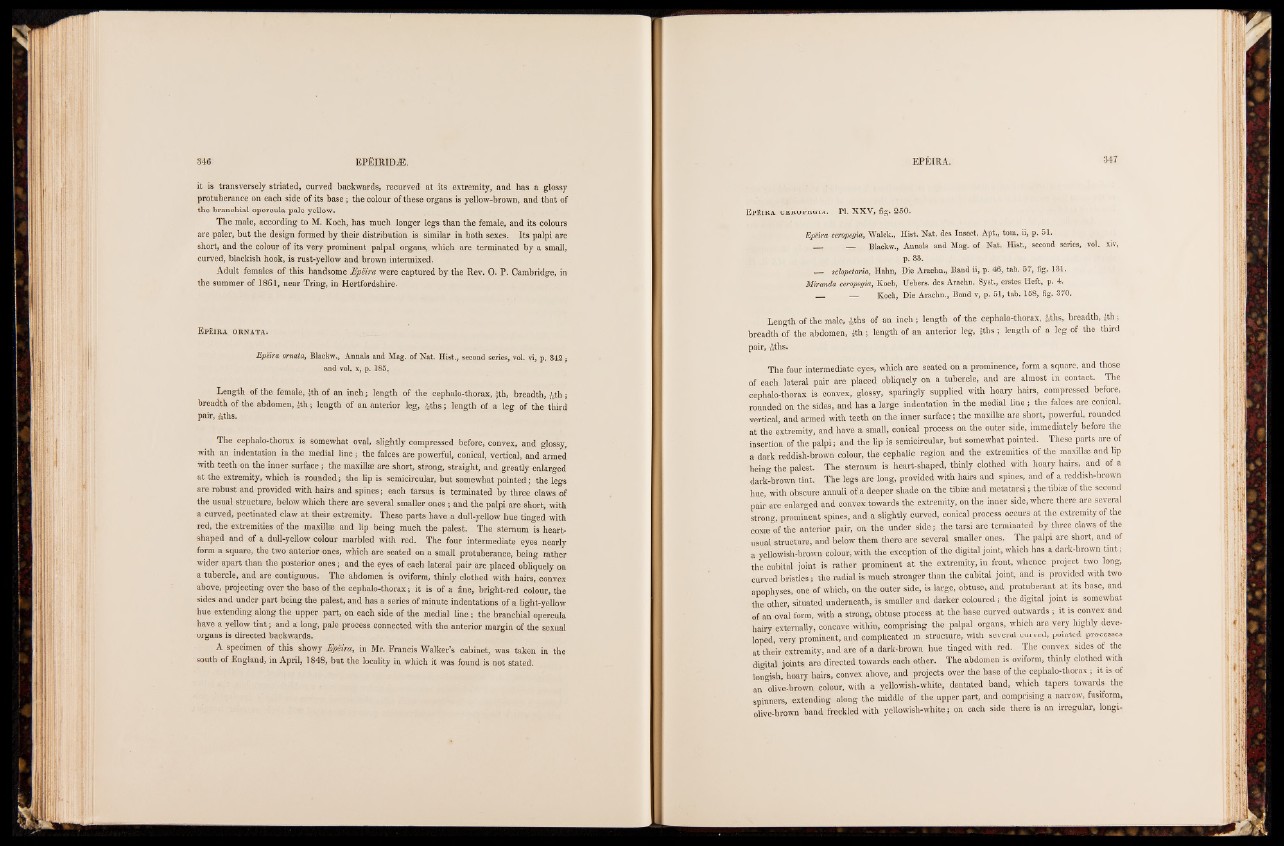
The male, according to M. Koch, has much longer legs than the female, and its colours
are paler, but the design formed by their distribution is similar in both sexes. Its palpi are
short, and the colour of its very prominent palpal organs, which are terminated by a small,
curved, blackish hook, is rust-yellow and brown intermixed.
Adult females of this handsome Epeira were captured by the Rev. 0 . P. Cambridge, in
the summer of 1861, near Tring, in Hertfordshire.
Epeira ornata.
Epeira ornata, Blackw., Annals and Mag. of Nat. Hist., second series, vol. vi, p. 842 ;
and vol. x, p. 185.
Length of the female, ,th of an inch; length of the cephalo-thorax, gth, breadth, ^ th ;
breadth of the abdomen, Jth; length of an anterior leg, Aths ; length of a leg of the third
pair, |{ths.
The cephalo-thorax is somewhat oval, slightly compressed before, convex, and glossy,
with an indentation in the medial lin e ; the falGes are powerful, conical, vertical, and armed
with teeth on the inner surface; the maxillm are short, strong, straight, and greatly enlarged
at the extremity, which is rounded; the lip is semicircular, but somewhat pointed; the legs
are robust and provided with hairs and spines; each tarsus is terminated by three claws of
the usual structure, below which there are several smaller ones ; and the palpi are short, with
a curved, pectinated claw at their extremity. These parts have a dull-yellow hne tinged with
red, the extremities of the maxillae and lip being much the palest. The sternum is heart-
shaped and of a dull-yellow colour marbled with red. The four intermediate eyes nearly
form a square, the two anterior ones, which are seated on a small protuberance, being rather
wider apart than the posterior ones; and the eyes of each lateral pair are placed obliquely on
a tubercle, and are contiguous. The abdomen is oviform, thinly clothed with hairs, convex
above, projecting over the base of the cephalo-thorax; it is of a fine, bright-red colour, the
sides and under part being the palest, and has a series of minute indentations of a light-yellow
hue extending along the upper part, on each side of the medial line ; the branchial opercula
have a yellow tint; and a long, pale process connected with the anterior margin of the sexual
organs is directed backwards.
A specimen of this showy Epeira, in Mr. Francis Walker’s cabinet, was taken in the
south of England, in April, 1848, but the locality in which it was found is not stated.
Epëira ceropegia. PI. XXV, fig. 250.
Epëira ceropegia, Walck., Hist. Nat, des Insect. Apt., tom. ii, p. 51.
__ Blackw., Annals and Mag. of Nat. Hist., second series, vol. xiv,
p. S3.
— sclopetaria, Hahn, Die Arachn., Band ii, p. 46, tab. 57, fig. 131.
Miranda ceropegia, Koch, Uebers. des Arachn. Syst., erstes Heft, p. 4.
__ __ Koch, Die Arachn., Band v, p. 51, tab. 158, fig. 370.
Length of the male, £ths of an in ch ; length of the cephalo-thorax, *ths, breadth, éth;
breadth of thé abdomen, Jth ; length of an anterior leg, jth s ; length of a leg of the third
pair, retbs.
The four intermediate eyes, which are seated, on a prominence, form a square, and those
of each lateral pair are placed obliquely on a tubercle, and are almost in contact. The
cephalo-thorax is convex, glossy, sparingly supplied with hoary hairs, compressed before,
rounded on the sides, and has a large indentation in the medial lin e ; the falces are conical,
vertical, and armed with teeth on the inner surface; the maxillae are short, powerful, rounded
at the extremity, and have a small, conical process on the outer side, immediately before the
insertion of the palpi; and the lip is semicircular, but somewhat pointed. These parts are of
a dark reddish-brown colour, the cephalic region and the extremities of the maxilla; and lip
'being the palest. The sternum is heart-shaped, thinly clothed with hoary hairs, and of a
dark-brown tint. The legs are long, provided with hairs and spines, and of a reddish-brown
hue, with obscure annuli of a deeper shade on the tibiae and metatarsi; the tibiae of the second
pair are enlarged and convex towards the extremity, on the inner side, where there are several
strong, prominent spines, and a slightly curved, conical process occurs at the extremity of the
coxae of the anterior pair, on the under side;...the tarsi are terminated by three claws of the
usual structure, and below them there are several smaller ones. The palpi are short, and of
a yellowish-brown colour, with the exception of the digitaljjjjint, which has a dark-brown tin t;
the cubital joint is rather prominent at the extremity, in front, whence project two long,
curved bristles; the radial is much stronger than the cubital joint, and is provided with two
apophyses, one of which, on the outer side, is large, obtuse, and protuberant at tts base, and
the other, situated underneath, is: smaller and darker coloured; the digital joint is somewhat
of an oval form, with a strong, obtuse process at the base curved outwards ; it is convex-and
hairy externally,: concave within, comprising the palpal organs, which are very highly developed,
very prominent, and complicated in structure, with several curved, pointed processes
at their extremity, and are of a dark-brown hue tinged with red. The convex sides of the
digital joints are directed towards each other. The abdomen is oviform, thinly clothed with
longish, hoary hairs, convex above, and projects over the base of the cephalo-thorax; it is of
an olive-brown colour, with a yellowish-white, dentated band, which tapers towards the
spinners, extending along the middle of the upper part, and comprising a narrow, fusiform,
olive-brown band freckled with yellowish-white; on each side there is an irregular, longi